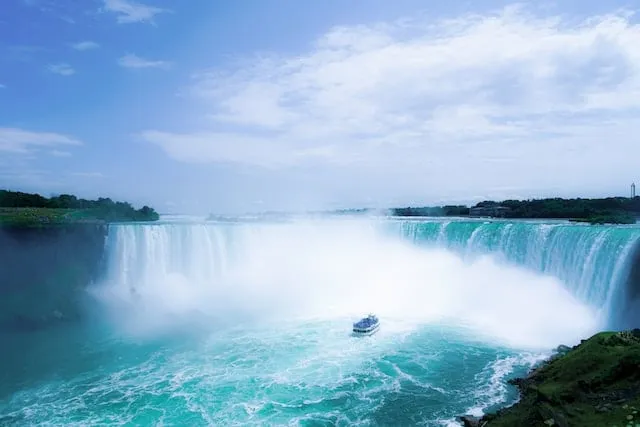Niagara Falls.

Nature's Majestic Masterpiece!
World-famous Niagara Falls is a spectacular example of the great strength and magnificence of nature. nestled along the line separating the US and Canada.
Visitors have been mesmerised by this magnificent waterfall system for generations.
This post will explore the fascinating geological structure, attractiveness, and history of Niagara Falls for tourists from all around the world.
A Geological Wonder:
The Niagara River, which empties Lake Erie into Lake Ontario, includes Niagara Falls. The American Falls, Bridal Veil Falls, and Horseshoe Falls (sometimes referred to as the Canadian Falls) are the three distinct cascades that make up the actual falls.
The combined flow rate of these waterfalls is the highest of any waterfall in the world. More than 12,000 years ago, during the last Ice Age, Niagara Falls first appeared.
The Great Lakes and the Niagara River were cut out by the gigantic glaciers as they withdrew, ultimately contributing to the formation of the falls.
The geological features of the falls are evidence of how quickly the planet's surface changes.
Historical Importance:
The Haudenosaunee (Iroquois) and Ongiara (Neutrals) tribes, among others, retained great cultural and spiritual significance for indigenous peoples for a very long time before European settlers arrived.
The falls were crucial to their oral traditions and rituals since they were seen as the home of the gods.
Samuel de Champlain, a French adventurer, first saw Niagara Falls in 1604 and was the first known European to do so. Over time, the falls attracted tourists from all over the world as a subject of intrigue for explorers, authors, and painters.
Awe-inspiring force and Beauty:
The Niagara Falls' incredible force and volume of water are breathtaking. The tallest of the three falls, Horseshoe Falls, rises to an astonishing 167 feet (51 metres) in height and stretches 2,200 feet (671 metres) along its coastline.
Approximately 85,000 cubic feet (2,400 cubic metres) of water pour over the falls each second. The immense force of the falls produces a roar that never stops and a mist that covers the region, creating a captivating and even supernatural environment.
There are many places where visitors can view the falls, including observation decks, boat cruises, and hiking trails.
Visiting Niagara Falls:
Niagara Falls is a year-round tourist site that provides visitors with a variety of activities. Boat cruises like the Maid of the Mist and Hornblower Cruises bring tourists up close to the falls during the summer, offering a thrilling and wet adventure.
A stunning, frozen wonderland is frequently created by the falls' mist in the winter, which covers neighbouring trees and rocks in a shimmering sheen of ice.
Visitors can find lodging, dining, and entertainment options in the Canadian town of Niagara Falls as well as the American city of Niagara Falls, New York.
Both sides of the border offer breathtaking views of the falls, and touring the nearby parks, such as Queen Victoria Park in Ontario and Niagara Falls State Park in New York, provides an opportunity for relaxing strolls and picnics.
Preservation and Conservation:
Niagara Falls' ecological importance and natural beauty have inspired ongoing conservation efforts.
The falls are safeguarded by national parks in both the United States and Canada, assuring the survival of this famous natural wonder for upcoming generations.
There are also programmes in place to improve sustainability and minimise pollution to protect the environment around the Niagara River.
In conclusion:
Niagara Falls is a timeless representation of the might and majesty of nature. It is a must-visit location for tourists from all over the world due to its geological formation, historical significance, and sheer visual spectacle.
The beauty of Niagara Falls, whether viewed from a boat, an observation deck, or a serene walking trail, creates an enduring imprint on everyone who has the luxury of witnessing it and serves as a constant reminder of the wonders that our world has to offer.


